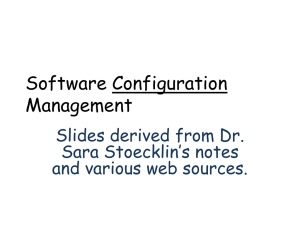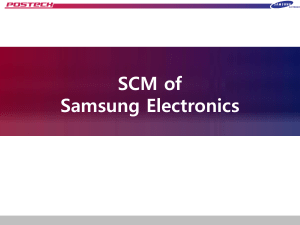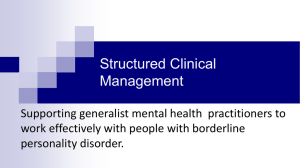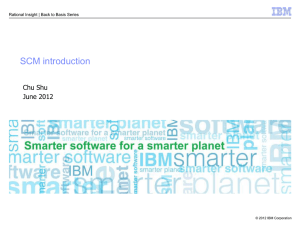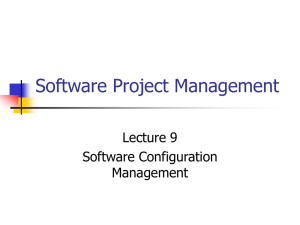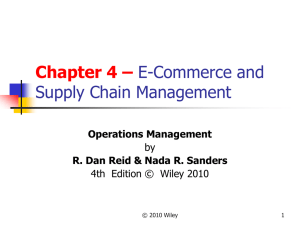17.Supply_Chain_Management
advertisement
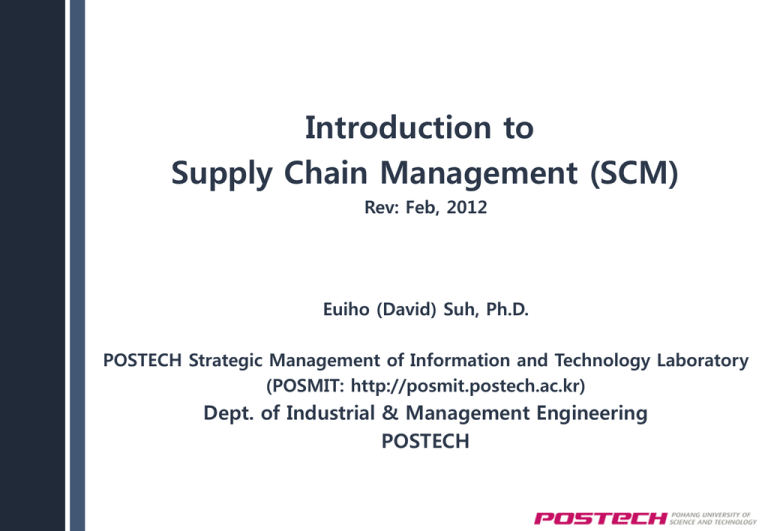
Introduction to Supply Chain Management (SCM) Rev: Feb, 2012 Euiho (David) Suh, Ph.D. POSTECH Strategic Management of Information and Technology Laboratory (POSMIT: http://posmit.postech.ac.kr) Dept. of Industrial & Management Engineering POSTECH Contents ※ Discussion Questions 1 Introduction 2 Motivation in SCM 3 Strategic approaches of SCM 4 Roles of SCM 5 Case Study Discussion Questions ■ Why do you think implementing SCM is difficult? ■ Find a successful case of SCM and explain it. ■ EDI involves the electronic exchange business transaction documents over the Internet or other networks between supply chain trading partners. ■ What is the concept explained in the below pharagraph? – A cross-functional interenterprise system that uses information technology to help support and manage the links between some of the organization's key business processes and those of its suppliers, customers, and partners. The intent is to create a fast, efficient, and low-cost network of business relationships to get an organization's products and services from concept to market. 3 What is a Supply Chain? 1. Introduction ■ Definition – The interrelationships with suppliers, customers, distributors, and other businesses that are needed to design, build, and sell a product make up the network of business entities, relationships, and processes Suppliers Material Costs Manufacturers Warehouses & Distribution Centers Transportation Costs Customers Transportation Costs Transportation Manufacturing Costs Inventory Costs Costs 4 Supply Chain Management 1. Introduction ■ Definition – Applying a total systems approach to the entire flow of information, materials and service throughout the supply chain to provide the right quantities of right stuff, to the right locations and at the right time, and so as to minimize total system cost subject to satisfying service requirements Management customer services Customer Relationship Management Satisfaction of ordering Management production Management demand Supply 5 Sales Strategy vs. Production Strategy 2. Motivation in SCM ■ What would sales & production costs have to be to double net income? Which is easier? Percentages are % of sales Current Situation Sales Strategy Production Strategy Sale $10 $? $ 10 Production $8 (80%) $ (80%) $? Marketing $1 (10%) $ (10%) $ (10%) Net Income $1 $2 $2 Reducing production costs is more feasible. ■ Solution Increase sales 100% Reduce production costs by 12% Current Situation Sales Strategy Production Strategy Sale $10 $ 20 $ 10 Production $8 (80%) $ (80%) $7 Marketing $1 (10%) $ (10%) $ (10%) Net Income $1 $2 $2 6 The Importance of Supply Chain Management (1/2) 2. Motivation in SCM ■ Dealing with uncertain environments – matching supply and demand – Boeing announced a $2.6 billion write-off in 1997 due to “raw materials shortages, internal and supplier parts shortages and productivity inefficiencies” – U.S Surgical Corporation announced a $22 million loss in 1993 due to “larger than anticipated inventories on the shelves of hospitals” – IBM sold out its supply of its new Aptiva PC in 1994 costing it millions in potential revenue – Hewlett-Packard and Dell found it difficult to obtain important components for its PC’s from Taiwanese suppliers in 1999 due to a massive earthquake ■ U.S. firms spent $898 billion (10% of GDP) on supply-chain related activities in 1998 7 The Importance of Supply Chain Management (2/2) 2. Motivation in SCM ■ Shorter product life cycles of high-technology products – Less opportunity to accumulate historical data on customer demand – Wide choice of competing products makes it difficult to predict demand ■ The growth of technologies such as the Internet enable greater collaboration between supply chain trading partners – If you don’t do it, your competitor will – Major buyers such as Wal-Mart demand a level of “supply chain maturity” of its suppliers ■ Availability of SCM technologies on the market – Firms have access to multiple products (e.g., SAP, Baan, Oracle, JD Edwards) with which to integrate internal processes 8 History of Supply Chain Management 2. Motivation in SCM 1960’s Inventory Management Focus, Cost Control 1970’s MRP & BOM – Operations Planning 1980’s MRPII, JIT - Materials Management, Logistics 1990’s SCM - ERP - “Integrated” Purchasing, Financials, Manufacturing, Order Entry 2000’s Optimized “Value Network” with Real-Time Decision Support; Synchronized & Collaborative Extended Network 9 Supply Chain Technology Market Grow 7% annually $ 9.2B $ 6.5B 2. Motivation in SCM “The supply chain, and the technologies that support it, will play an important role in helping companies deal and thrive in an economy that is going to be quite unlike anything we’ve seen in the post-war era,” - John Fontanella vice president of research at AMR Research 2008 2012 (source : AMR research, 2008) 10 Why Is SCM Difficult? 2. Motivation in SCM ■ Uncertainty is inherent to every supply chain – – – – Travel times Breakdowns of machines and vehicles Weather, natural catastrophe, war Local politics, labor conditions, border issues ■ The complexity of the problem to globally optimize a supply chain is significant – Minimize internal costs – Minimize uncertainty – Deal with remaining uncertainty Plan Source Make 11 Deliver Buy Electronic Data Interchange (EDI) 3. Strategic approaches of SCM ■ The electronic exchange of business transaction documents between supply chain trading partners ■ One of the earliest uses of information technology for supply chain management ■ The almost complete automation of an e-commerce supply chain process ■ Many transactions occur over the Internet, using secure virtual private networks ■ A communications standard for sharing business documents and settlement information among firms 12 Today’s Marketplace Requires: ■ ■ ■ ■ ■ 3. Strategic approaches of SCM Personalized content and services for their customers Collaborative planning with design partners, distributors, and suppliers Real-time commitments for design, production, inventory, and transportation capacity Flexible logistics options to ensure timely fulfillment Order tracking & reporting across multiple vendors and carriers Shared visibility for trading partners 13 Supply Chain Management – Key Issues (1/3) 3. Strategic approaches of SCM ■ Forecasts are never right – Very unlikely that actual demand will exactly equal forecast demand ■ The longer the forecast horizon, the worse the forecast – A forecast for a year from now will never be as accurate as a forecast for 3 months from now ■ Aggregate forecasts are more accurate – A demand forecast for all CV therapeutics will be more accurate than a forecast for a specific CV-related product ■ Nevertheless, forecasts (or plans, if you prefer) are important management tools when some methods are applied to reduce uncertainty 14 Supply Chain Management – Key Issues (2/3) 3. Strategic approaches of SCM ■ Overcoming functional silos with conflicting goals Purchasing Low purchase price Multiple vendors SOURCE Manufacturing Distribution Few changeovers Low inventories Stable schedules Low transportation Long run lengths MAKE DELIVER 15 Customer Service/ Sales High inventories High service levels Regional stocks SELL Supply Chain Management – Key Issues (3/3) ISSUE 3. Strategic approaches of SCM CONSIDERATIONS Network Planning • Warehouse locations and capacities • Plant locations and production levels • Transportation flows between facilities to minimize cost and time Inventory Control • How should inventory be managed? • Why does inventory fluctuate and what strategies minimize this? Supply Contracts • Impact of volume discount and revenue sharing • Pricing strategies to reduce order-shipment variability Distribution Strategies Integration and Strategic Partnering Outsourcing & Procurement Strategies Product Design • Selection of distribution strategies (e.g., direct ship vs. cross-docking) • How many cross-dock points are needed? • Cost/Benefits of different strategies • • • • How can integration with partners be achieved? What level of integration is best? What information and processes can be shared? What partnerships should be implemented and in which situations? • What are our core supply chain capabilities and which are not? • Does our product design mandate different outsourcing approaches? • Risk management • How are inventory holding and transportation costs affected by product design? • How does product design enable mass customization? 16 Supply Chain Management Operations Strategies STRATEGY WHEN TO CHOOSE 3. Strategic approaches of SCM BENEFITS Make to Stock Low manufacturing costs; standardized products, meet customer demands relatively predictable demand quickly Make to Order customized products, many variations Configure to Order many variations on finished product; infrequent demand Engineer to Order complex products, unique customer specifications 17 Customization; reduced inventory; improved service levels Low inventory levels; wide range of product offerings; simplified planning Enables response to specific customer requirements Role and Goals of SCM 4. Roles of SCM ■ Role of SCM – SCM management helps a company get the right products to the right place at the right time, in the proper quantity and at an acceptable cost. ■ Goals of SCM – To manage a process efficiently by forecasting demand – Controlling inventory – Enhancing the network of business relationships with customers, suppliers, distributors, and others – Receiving feedback on the status of every link in the supply chain 18 Supply Chain Management – Benefits 4. Roles of SCM ■ A 1997 PRTM Integrated Supply Chain Benchmarking Survey of 331 firms found significant benefits to integrating the supply chain Delivery Performance 16%-28% Improvement Inventory Reduction 25%-60% Improvement Fulfillment Cycle Time 30%-50% Improvement Forecast Accuracy 25%-80% Improvement Overall Productivity 10%-16% Improvement Lower Supply-Chain Costs 25%-50% Improvement Fill Rates 20%-30% Improvement Improved Capacity Realization 10%-20% Improvement Source: Cohen & Roussel 19 Benefits and Challenges of SCM 4. Roles of SCM ■ Key Benefits – – – – – Faster, more accurate order processing Strategic relationships with supplier Lower transaction and materials cost Quicker times to market Reductions in inventory levels ■ Key Challenges – Lack of demand planning knowledge, tools, and guidelines – Inaccurate data provided by other information systems – Lack of collaboration among marketing, production, and inventory management – SCM tools are immature, incomplete, and hard to implement 20 Case Study ■ In the Text book – Real World Case 3 : Perdue Farms and Others: Supply Chain Management Meets the Holiday Season ■ Domestic Case Click Here 21 Reference ■ O’Brien & Marakas, “Introduction to Information Systems – Fifteenth Edition”, McGraw – Hill, Chapter 7, pp. 276~281 ■ Keebom Kang, “Global Logistics and Information Technology(PPTSlide)”, Graduate School of Business Naval Postgraduate School ■ Keebom Kang, “B2B: Applications for Improving Supplier Selection(PPTSlide)”, Graduate School of Business Naval Postgraduate School ■ “Basics of Supply Chain Management(PPTSlide)”, Stevens Institute of Technology 22



